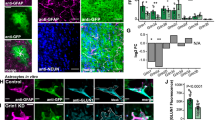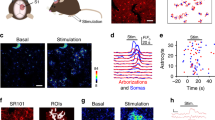Abstract
Although astrocytes are the most abundant cell type in the brain, evidence for their activation during physiological sensory activity is lacking. Here we show that whisker stimulation evokes increases in astrocytic cytosolic calcium (Ca2+) within the barrel cortex of adult mice. Increases in astrocytic Ca2+ were a function of the frequency of stimulation, occurred within several seconds and were inhibited by metabotropic glutamate receptor antagonists. To distinguish between synaptic input and output, local synaptic activity in cortical layer 2 was silenced by iontophoresis of AMPA and NMDA receptor antagonists. The antagonists did not reduce astrocytic Ca2+ responses despite a marked reduction in excitatory postsynaptic currents in response to whisker stimulation. These findings indicate that astrocytes respond to synaptic input, by means of spillover or ectopic release of glutamate, and that increases in astrocytic Ca2+ occur independently of postsynaptic excitatory activity.
This is a preview of subscription content, access via your institution
Access options
Subscribe to this journal
Receive 12 print issues and online access
$209.00 per year
only $17.42 per issue
Buy this article
- Purchase on Springer Link
- Instant access to full article PDF
Prices may be subject to local taxes which are calculated during checkout





Similar content being viewed by others
References
Dani, J.W., Chernjavsky, A. & Smith, S.J. Neuronal activity triggers calcium waves in hippocampal astrocyte networks. Neuron 8, 429–440 (1992).
Kang, J., Jiang, L., Goldman, S. & Nedergaard, M. Astrocyte-mediated potentiation of inhibitory synaptic transmission. Nat. Neurosci. 1, 683–692 (1998).
Kettenmann, H. Physiology of glial cells. Adv. Neurol. 79, 565–571 (1999).
Volterra, A. & Meldolesi, J. Astrocytes, from brain glue to communication elements: the revolution continues. Nat. Rev. Neurosci. 6, 626–640 (2005).
Cornell-Bell, A.H., Finkbeiner, S.M., Cooper, M.S. & Smith, S.J. Glutamate induces calcium waves in cultured astrocytes: long-range glial signaling. Science 247, 470–473 (1990).
Arcuino, G. et al. Intercellular calcium signaling mediated by point-source burst release of ATP. Proc. Natl. Acad. Sci. USA 99, 9840–9845 (2002).
Cotrina, M. & Nedergaard, M. Intracellular calcium control mechanisms in glia. in Neuroglia. (eds. Kettenmann, H. & Ransom, B.R.) Ch. 17, 229–239 (Oxford Univ. Press, New York, 2005).
Zhang, J.M. et al. ATP released by astrocytes mediates glutamatergic activity-dependent heterosynaptic suppression. Neuron 40, 971–982 (2003).
Pascual, O. et al. Astrocytic purinergic signaling coordinates synaptic networks. Science 310, 113–116 (2005).
Dunwiddie, T.V., Diao, L. & Proctor, W.R. Adenine nucleotides undergo rapid, quantitative conversion to adenosine in the extracellular space in rat hippocampus. J. Neurosci. 17, 7673–7682 (1997).
Zonta, M. et al. Neuron-to-astrocyte signaling is central to the dynamic control of brain microcirculation. Nat. Neurosci. 6, 43–50 (2003).
Araque, A., Sanzgiri, R.P., Parpura, V. & Haydon, P.G. Calcium elevation in astrocytes causes an NMDA receptor-dependent increase in the frequency of miniature synaptic currents in cultured hippocampal neurons. J. Neurosci. 18, 6822–6829 (1998).
Rzigalinski, B.A., Weber, J.T., Willoughby, K.A. & Ellis, E.F. Intracellular free calcium dynamics in stretch-injured astrocytes. J. Neurochem. 70, 2377–2385 (1998).
Venance, L., Stella, N., Glowinski, J. & Giaume, C. Mechanism involved in initiation and propagation of receptor-induced intercellular calcium signaling in cultured rat astrocytes. J. Neurosci. 17, 1981–1992 (1997).
Newman, E.A. Calcium increases in retinal glial cells evoked by light-induced neuronal activity. J. Neurosci. 25, 5502–5510 (2005).
Hirase, H., Qian, L., Bartho, P. & Buzsaki, G. Calcium dynamics of cortical astrocytic networks in vivo. PLoS Biol. 2, E96 (2004).
Tian, G.F. et al. An astrocytic basis of epilepsy. Nat. Med. 11, 973–981 (2005).
Nimmerjahn, A., Kirchhoff, F., Kerr, J.N.D. & Helmchen, F. Sulforhodamine 101 as a specific marker of astroglia in the neocortex in vivo. Nature Methods 1, 31–37 (2004).
Petersen, C.C., Grinvald, A. & Sakmann, B. Spatiotemporal dynamics of sensory responses in layer 2/3 of rat barrel cortex measured in vivo by voltage-sensitive dye imaging combined with whole-cell voltage recordings and neuron reconstructions. J. Neurosci. 23, 1298–1309 (2003).
Petersen, C.C. & Sakmann, B. Functionally independent columns of rat somatosensory barrel cortex revealed with voltage-sensitive dye imaging. J. Neurosci. 21, 8435–8446 (2001).
Feldmeyer, D., Lubke, J., Silver, R.A. & Sakmann, B. Synaptic connections between layer 4 spiny neurone-layer 2/3 pyramidal cell pairs in juvenile rat barrel cortex: physiology and anatomy of interlaminar signalling within a cortical column. J. Physiol. (Lond.) 538, 803–822 (2002).
Brickley, S.G., Farrant, M. & Swanson, G.T. & Cull-Candy, S.G. CNQX increases GABA-mediated synaptic transmission in the cerebellum by an AMPA/kainate receptor-independent mechanism. Neuropharmacology 41, 730–736 (2001).
Fellin, T. et al. Neuronal synchrony mediated by astrocytic glutamate through activation of extrasynaptic NMDA receptors. Neuron 43, 729–743 (2004).
Takano, T. et al. Astrocyte-mediated control of cerebral blood flow. Nat. Neurosci. 9, 260–267 (2006).
Kew, J.N. & Kemp, J.A. Ionotropic and metabotropic glutamate receptor structure and pharmacology. Psychopharmacology (Berl.) 179, 4–29 (2005).
Mathiesen, C., Caesar, K., Akgoren, N. & Lauritzen, M. Modification of activity-dependent increases of cerebral blood flow by excitatory synaptic activity and spikes in rat cerebellar cortex. J. Physiol. (Lond.) 512, 555–566 (1998).
Chung, S., Li, X. & Nelson, S.B. Short-term depression at thalamocortical synapses contributes to rapid adaptation of cortical sensory responses in vivo. Neuron 34, 437–446 (2002).
Porter, J.T. & McCarthy, K.D. GFAP-positive hippocampal astrocytes in situ respond to glutamatergic neuroligands with increases in [Ca2+]i. Glia 13, 101–112 (1995).
Huang, Y.H. & Bergles, D.E. Glutamate transporters bring competition to the synapse. Curr. Opin. Neurobiol. 14, 346–352 (2004).
Matsui, K. & Jahr, C.E. Ectopic release of synaptic vesicles. Neuron 40, 1173–1183 (2003).
Duffy, S. & MacVicar, B.A. Adrenergic calcium signaling in astrocyte networks within the hippocampal slice. J. Neurosci. 15, 5535–5550 (1995).
Perea, G. & Araque, A. Properties of synaptically evoked astrocyte calcium signal reveal synaptic information processing by astrocytes. J. Neurosci. 25, 2192–2203 (2005).
Nilsson, M., Hansson, E. & Ronnback, L. Adrenergic and 5–HT2 receptors on the same astroglial cell. A microspectrofluorimetric study on cytosolic Ca2+ responses in single cells in primary culture. Brain Res. Dev. Brain Res. 63, 33–41 (1991).
Stout, C. & Charles, A. Modulation of intercellular calcium signaling in astrocytes by extracellular calcium and magnesium. Glia 43, 265–273 (2003).
Pasti, L., Volterra, A., Pozzan, T. & Carmignoto, G. Intracellular calcium oscillations in astrocytes: a highly plastic, bidirectional form of communication between neurons and astrocytes in situ. J. Neurosci. 17, 7817–7830 (1997).
Liu, Q.S., Xu, Q., Arcuino, G., Kang, J. & Nedergaard, M. Astrocyte-mediated activation of neuronal kainate receptors. Proc. Natl. Acad. Sci. USA 101, 3172–3177 (2004).
Parri, H.R., Gould, T.M. & Crunelli, V. Spontaneous astrocytic Ca2+ oscillations in situ drive NMDAR-mediated neuronal excitation. Nat. Neurosci. 4, 803–812 (2001).
Angulo, M.C., Kozlov, A.S., Charpak, S. & Audinat, E. Glutamate released from glial cells synchronizes neuronal activity in the hippocampus. J. Neurosci. 24, 6920–6927 (2004).
Schuchmann, S., Albrecht, D., Heinemann, U. & von Bohlen und Halbach, O. Nitric oxide modulates low-Mg2+-induced epileptiform activity in rat hippocampal-entorhinal cortex slices. Neurobiol. Dis. 11, 96–105 (2002).
Ye, Z.C., Wyeth, M.S., Baltan-Tekkok, S. & Ransom, B.R. Functional hemichannels in astrocytes: a novel mechanism of glutamate release. J. Neurosci. 23, 3588–3596 (2003).
Fiacco, T.A. & McCarthy, K.D. Intracellular astrocyte calcium waves in situ increase the frequency of spontaneous AMPA receptor currents in CA1 pyramidal neurons. J. Neurosci. 24, 722–732 (2004).
Logothetis, N.K. The neural basis of the blood-oxygen-level-dependent functional magnetic resonance imaging signal. Phil. Trans. R. Soc. Lond. B 357, 1003–1037 (2002).
Magistretti, P.J. & Pellerin, L. Cellular mechanisms of brain energy metabolism and their relevance to functional brain imaging. Phil. Trans. R. Soc. Lond. B 354, 1155–1163 (1999).
Kasischke, K.A., Vishwasrao, H.D., Fisher, P.J., Zipfel, W.R. & Webb, W.W. Neural activity triggers neuronal oxidative metabolism followed by astrocytic glycolysis. Science 305, 99–103 (2004).
Nett, W.J., Oloff, S.H. & McCarthy, K.D. Hippocampal astrocytes in situ exhibit calcium oscillations that occur independent of neuronal activity. J. Neurophysiol. 87, 528–537 (2002).
Haydon, P.G. GLIA: listening and talking to the synapse. Nat. Rev. Neurosci. 2, 185–193 (2001).
Nedergaard, M., Ransom, B. & Goldman, S.A. New roles for astrocytes: redefining the functional architecture of the brain. Trends Neurosci. 26, 523–530 (2003).
Zlokovic, B.V. Neurovascular mechanisms of Alzheimer's neurodegeneration. Trends Neurosci. 28, 202–208 (2005).
Ahissar, E., Sosnik, R. & Haidarliu, S. Transformation from temporal to rate coding in a somatosensory thalamocortical pathway. Nature 406, 302–306 (2000).
Battaglia, G. et al. Endogenous activation of mGlu5 metabotropic glutamate receptors contributes to the development of nigro-striatal damage induced by 1-methyl-4-phenyl-1,2,3,6-tetrahydropyridine in mice. J. Neurosci. 24, 828–835 (2004).
Acknowledgements
We thank S. Goldman, K. Kasischke, E. Vates, L. Bekar and N. Oberheim for their comments on the manuscript and D. Pinto for discussion. This work was supported in part by grants NS30007 and NS38073 from the US National Institutes of Health and the National Institute of Neurological Disorders and Stroke (to M.N.) and the Phillip Morris External Research Program.
Author information
Authors and Affiliations
Corresponding author
Ethics declarations
Competing interests
The authors declare no competing financial interests.
Supplementary information
Supplementary Fig. 1
Spontaneous astrocytic Ca2+ activity in anesthetized mice. (PDF 414 kb)
Supplementary Fig. 2
The frequency of astrocytic Ca2+ oscillations was artificially increased with increased 2-photon laser power. (PDF 455 kb)
Supplementary Fig. 3
Astrocytic Ca2+ responses to whisker stimulation are not modulated by 2-photon excitation when laser power is low. (PDF 502 kb)
Supplementary Fig. 4
1 Hz whisker stimulation failed to induce astrocytic Ca2+ increase. (PDF 287 kb)
Supplementary Video 1
Z step imaging of adult FVB mouse loaded with fluo-4/am. (MOV 1913 kb)
Supplementary Video 2
Spontaneous astrocytic Ca2+ signaling in barrel cortex layer 2. (MOV 2393 kb)
Supplementary Video 3
Whisker stimulation repeatedly triggered astrocytic Ca2+ increases in barrel cortex layer 2. (MOV 2386 kb)
Rights and permissions
About this article
Cite this article
Wang, X., Lou, N., Xu, Q. et al. Astrocytic Ca2+ signaling evoked by sensory stimulation in vivo. Nat Neurosci 9, 816–823 (2006). https://doi.org/10.1038/nn1703
Received:
Accepted:
Published:
Issue Date:
DOI: https://doi.org/10.1038/nn1703
This article is cited by
-
Distinct astrocytic modulatory roles in sensory transmission during sleep, wakefulness, and arousal states in freely moving mice
Nature Communications (2023)
-
Modeling the relationship between neuronal activity and the BOLD signal: contributions from astrocyte calcium dynamics
Scientific Reports (2023)
-
Glymphatic influx and clearance are accelerated by neurovascular coupling
Nature Neuroscience (2023)
-
Chronic brain damage in HIV-infected individuals under antiretroviral therapy is associated with viral reservoirs, sulfatide release, and compromised cell-to-cell communication
Cellular and Molecular Life Sciences (2023)
-
Astrocytes amplify neurovascular coupling to sustained activation of neocortex in awake mice
Nature Communications (2022)



